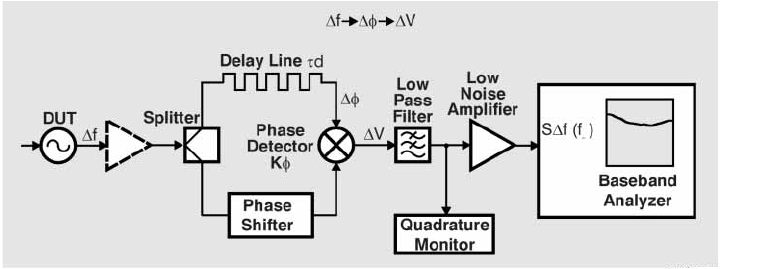User`s guide
Table Of Contents
- Title Page
- Contents
- Getting Started
- Introduction and Measurement
- Phase Noise Basics
- Expanding Your Measurement Experience
- Starting the Measurement Software
- Using the Asset Manager
- Using the Server Hardware Connections to Specify the Source
- Setting GPIB Addresses
- Testing the 8663A Internal/External 10 MHz
- Testing the 8644B Internal/External 10 MHz
- Viewing Markers
- Omitting Spurs
- Displaying the Parameter Summary
- Exporting Measurement Results
- Absolute Measurement Fundamentals
- Absolute Measurement Examples
- Residual Measurement Fundamentals
- What is Residual Noise?
- Assumptions about Residual Phase Noise Measurements
- Calibrating the Measurement
- Measurement Difficulties
- Residual Measurement Examples
- FM Discriminator Fundamentals
- FM Discriminator Measurement Examples
- AM Noise Measurement Fundamentals
- AM Noise Measurement Examples
- Baseband Noise Measurement Examples
- Evaluating Your Measurement Results
- Advanced Software Features
- Reference Graphs and Tables
- Approximate System Noise Floor vs. R Port Signal Level
- Phase Noise Floor and Region of Validity
- Phase Noise Level of Various Agilent Sources
- Increase in Measured Noise as Ref Source Approaches DUT Noise
- Approximate Sensitivity of Delay Line Discriminator
- AM Calibration
- Voltage Controlled Source Tuning Requirements
- Tune Range of VCO for Center Voltage
- Peak Tuning Range Required by Noise Level
- Phase Lock Loop Bandwidth vs. Peak Tuning Range
- Noise Floor Limits Due to Peak Tuning Range
- Tuning Characteristics of Various VCO Source Options
- 8643A Frequency Limits
- 8644B Frequency Limits
- 8664A Frequency Limits
- 8665A Frequency Limits
- 8665B Frequency Limits
- System Specifications
- System Interconnections
- PC Components Installation
- Overview
- Step 1: Uninstall the current version of Agilent Technologies IO libraries
- Step 2: Uninstall all National Instruments products.
- Step 3: Install the National Instruments VXI software.
- Step 4: Install the National Instruments VISA runtime.
- Step 5: Install software for the NI Data Acquisition Software.
- Step 6: Hardware Installation
- Step 7. Finalize National Instruments Software Installation.
- Step 8: System Interconnections
- Step 9: Install Microsoft Visual C++ 2008 Redistributable Package use default settings
- Step 10: Install the Agilent I/O Libraries
- Step 11: Install the E5500 Phase Noise Measurement software.
- Step 12: Asset Configuration
- Step 13: License Key for the Phase Noise Test Set
- Overview
- PC Digitizer Performance Verification
- Preventive Maintenance
- Service, Support, and Safety Information
- Safety and Regulatory Information
- Safety summary
- Equipment Installation
- Environmental conditions
- Before applying power
- Ground the instrument or system
- Fuses and Circuit Breakers
- Maintenance
- Safety symbols and instrument markings
- Regulatory Compliance
- Declaration of Conformity
- Compliance with German noise requirements
- Compliance with Canadian EMC requirements
- Service and Support
- Return Procedure
- Safety and Regulatory Information

246 Agilent E5505A User’s Guide
9
FM Discriminator Fundamentals
The Frequency Discriminator Method
Unlike the phase detector method, the frequency discriminator method does
not require a second reference source phase locked to the source under test.
See Figure 178.
.
This makes the frequency discriminator method extremely useful for
measuring sources that are difficult to phase lock, including sources that are
microphonic or drift quickly. It can also be used to measure sources with
high-level, low-rate phase noise, or high close-in spurious sidebands,
conditions with can pose serious problems for the phase detector method. A
wide-band delay line frequency discriminator is easy to implement using the
E5505A Phase Noise Measurement System and common coaxial cable.
Basic theory
The delay line implementation of the frequency discriminator (Figure 178)
converts short-term frequency fluctuations of a source into voltage
fluctuations that can be measured by a baseband analyzer. The conversion is a
two part process, first converting the frequency fluctuations into phase
fluctuations, and then converting the phase fluctuations to voltage
fluctuations.
The frequency fluctuation to phase fluctuation transformation ( ) takes
place in the delay line. The nominal frequency arrives at the double-balanced
mixer at a particular phase. As the frequency changes slightly, the phase shift
incurred in the fixed delay time will change proportionally. The delay line
converts the frequency change at the line input to a phase change a the line
output when compared to the undelayed signal arriving at the mixer in the
second path.
Figure 178 Basic delay line/mixer frequency discriminator method
Δf Δφ→










